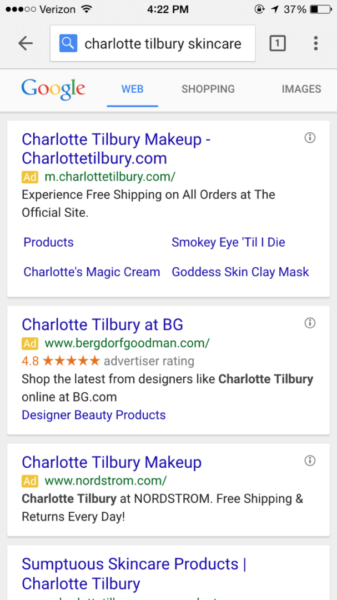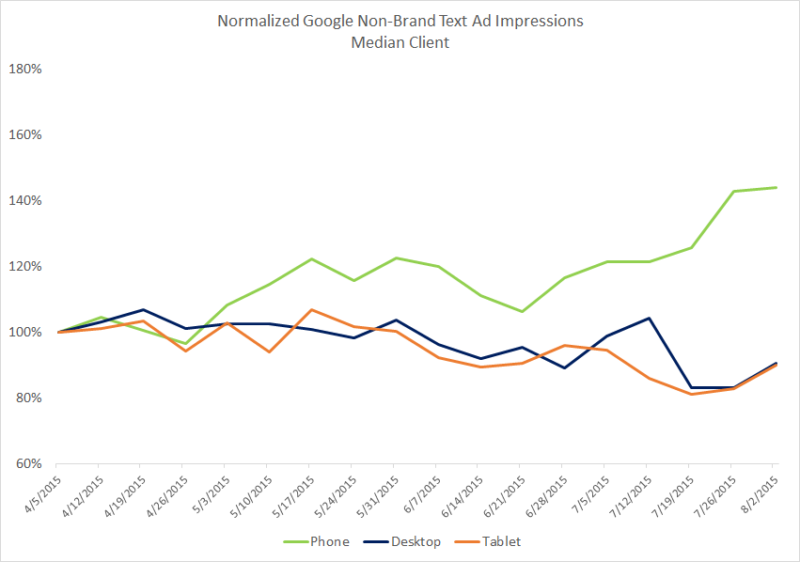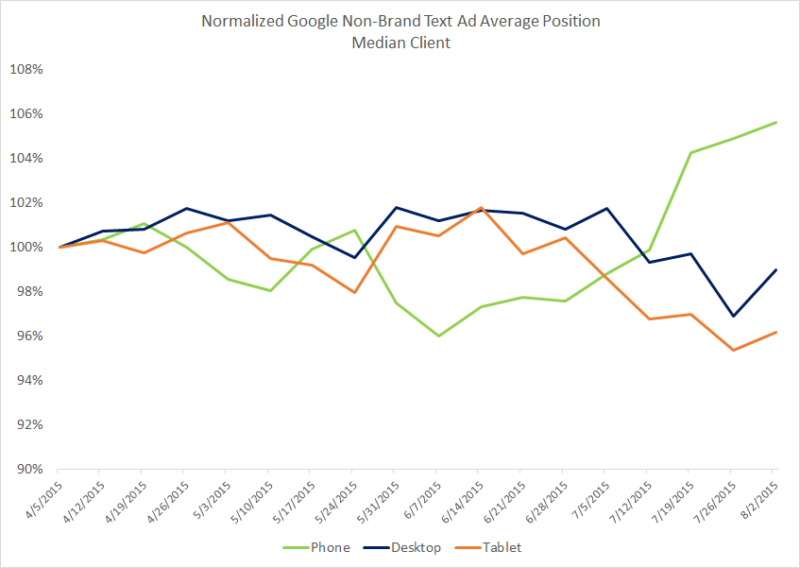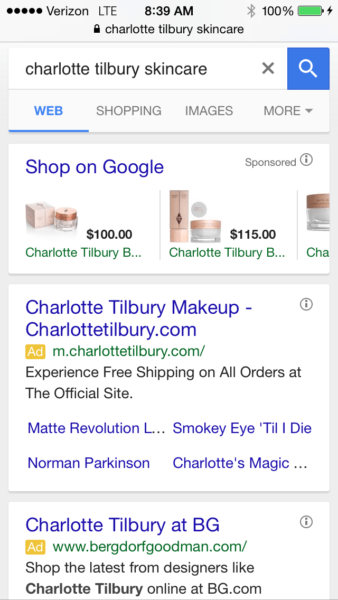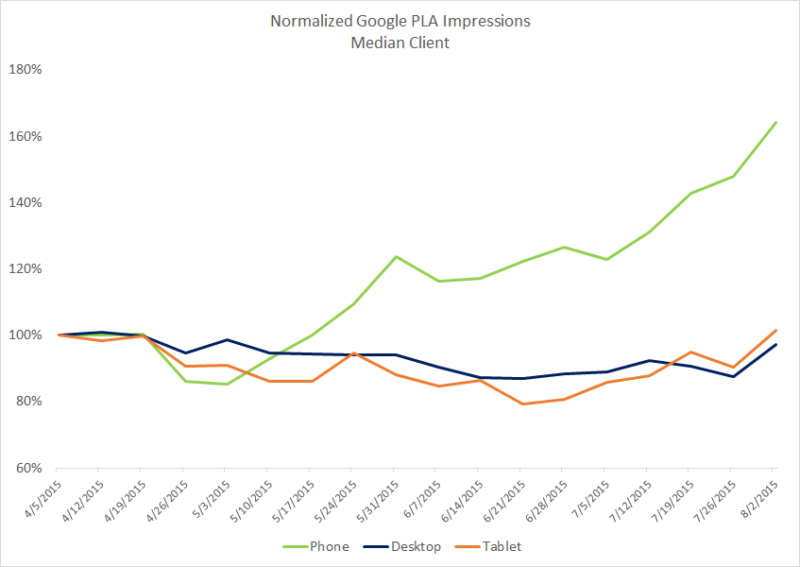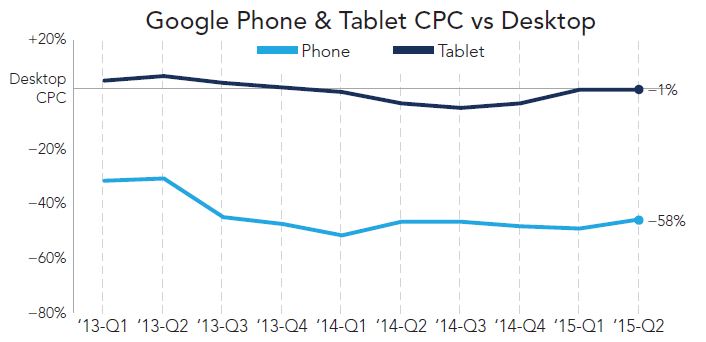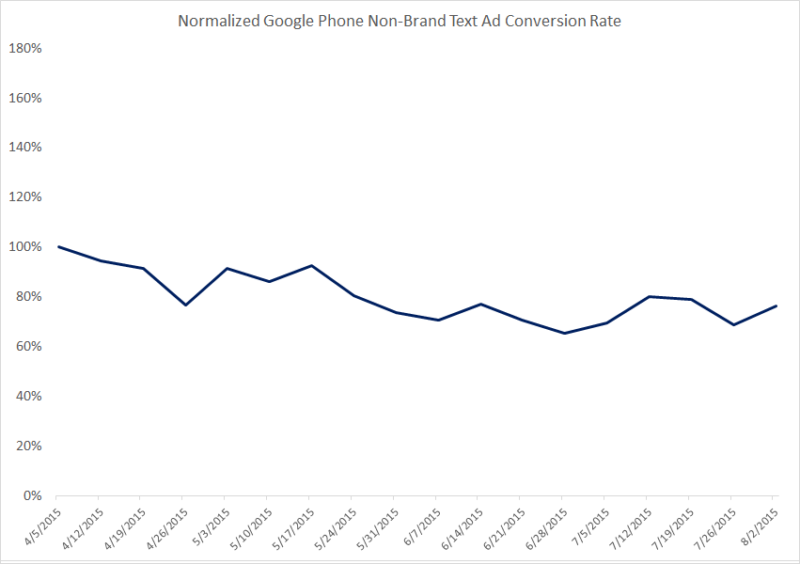The Early Impact Of Google Adding More Ads To Mobile SERPs
Columnist Andy Taylor shares data from Merkle|RKG suggesting that Google is now showing more ads in mobile search.

There have been reports that Google recently updated its mobile search listings to increasingly include three text ads instead of two at the top of the page for some search queries. By analyzing Merkle|RKG data, we’ve been able to confirm this change and take a look at what the change might mean for search advertisers.
While Google has shown three text ads in the past, it appears that the three-ad format has become more prevalent over the past few weeks.
Taking a look in the wild, we are finding examples of three text ads showing, as evidenced by the screenshot below.
Looking at data across dozens of advertisers, this change appears to already be impacting paid search performance and may end up resulting in significant increases in ad phone traffic for many advertisers.
Impressions Surge As Average Position Moves Farther Down The Page
Historically, searches on phones have typically produced only two text ads, with the possibility of a Product Listing Ad (PLA) carousel showing, as well.
As a result, it’s been much more competitive to get on the first page of results for searches on phones than on desktop, and the click-through rate of ads is much higher on phones, as users have fewer options to choose from.
With one more ad showing on the page, advertisers stand to receive more impressions on phones. Looking to the data, the median advertiser has seen a fairly significant increase in phone ad impressions over the last few weeks.
This increase appears to begin in late June/early July, at a time when no corresponding increase in impressions was observed for desktop or tablet devices.
If these impressions were occurring lower on the page in a newly minted third position, we would expect the average position to fall farther down the page.
Again, we see just that, with phone average position moving farther down the page, while the average positions of desktop and tablet devices show no such trend over the past few weeks.
Note that an increase in normalized average position represents movement down the page for the average impression.
The shift in phone average position is fairly small (about a tenth of a position) thus far, but has moved a lot since late June relative to past shifts in phone average position.
Coupled with the simultaneous increase in text ad impressions, the data seem to line up with the stories of Google increasingly rolling out three text ads instead of two for some queries.
Text Ads Do Not Appear To Be Cannibalizing PLA Impressions
The query that produced the three-text-ad screenshot above, [charlotte tilbury skincare], also still produces a PLA carousel, along with two text ads for some phone searches:
Thus, it appears that when a third text ad is shown, it takes the place of the PLA carousel, which is shown when there are only two text ads. Therefore, one potential impact of the three text ad experience would be a decline in PLA impressions on phones.
Taking a look at Google PLA data, however, one can see there’s been no decline in phone impressions over the past few weeks; it appears increases in PLA impressions since April have only accelerated since the beginning of the text ad trends.
As the increase in text ad impressions has come with only a very slight movement down the page in average position for the median client, and yet we’re seeing very large increases in text ad impressions and PLA impressions, these trends may not be entirely the result of a third ad showing on some searches.
Google may also be showing ads, both text and PLAs, for a greater share of searches on phones in general.
Of course, more and more searches are occurring on mobile devices every day, and we would expect ad impressions on phones to increase over time. However, the significance of the increases in PLA and text ad impressions on phones suggests something other than user behavior as the cause.
This would be in stark contrast to the apparent decline in impressions on desktop computers, which Merkle|RKG has been reporting on for some time.
This has been accompanied by skyrocketing first page minimum bid estimates for text ads provided by Google, strong increases in CPC for both brand and non-brand keywords and declining click growth.
We may see just the opposite trends occurring on phones as a result of this update.
How Will CPCs Move?
As the third position now affords advertisers the ability to garner clicks at lower CPCs than were required in the top two positions, this may put downward pressure on phone text ad CPCs in the future.
Thus far, we’ve seen very little movement from phone CPCs relative to those observed prior to the shifts in impressions and average position.
How this change will affect the gap between mobile and desktop CPCs will depend on which queries are most likely to trigger three text ad impressions. Our latest quarterly Digital Marketing Report showed phone CPCs were 58 percent lower than desktop CPCs in Q2.
That figure could move up or down for Q3 depending on the average phone CPC relative to desktop of the queries which are allowed to show three text ads.
If the queries have a higher phone CPC relative to desktop than the average, the gap could actually remain the same or get smaller, despite the fact that a click on the newly placed ad in the third position would produce a lower CPC than a click on the first two ads.
If virtually all queries started showing three text ads, we would expect the gap in CPC to get larger, all other variables constant.
Phone Traffic Volume Increasing As Conversion Rate Holds Steady
Not surprisingly, the increase in impressions has resulted in a corresponding increase in clicks from phone ads:
While phone conversion rate is down relative to early April of this year, the uptick in clicks over the past few weeks does not appear to have resulted in any real change in conversion rate from what was observed in late May/early June.
Implications for Organic Traffic
Our Q2 data showed 44 percent year-over-year growth in organic visits from phones, accounting for much of the 12 percent overall organic visit growth.
Expanding the number of text ads from two to three will likely slow the growth rate of organic visits on phones in Q3, which in turn will likely reduce the overall organic visit growth rate.
Again, this is the exact opposite of the impact coming from fewer ads being shown on desktop computers, which helped to drive up overall organic growth by moving desktop organic visits from negative to positive growth.
Conclusion
Paid search data from the past few weeks seems to back up claims that Google is rolling out three text ads for searches on phones where there used to only be two.
This should result in a greater share of paid search traffic coming from phones, especially in light of the fact that fewer ads are showing on desktop.
However, sites will also likely see less organic traffic as a result of the third ad taking up additional real estate on the page. This won’t be lost on SEOs who have long lamented Google’s moves to direct search traffic to ads, to Google-owned properties or to answers found directly on the results page.
Contributing authors are invited to create content for Search Engine Land and are chosen for their expertise and contribution to the search community. Our contributors work under the oversight of the editorial staff and contributions are checked for quality and relevance to our readers. The opinions they express are their own.
Related stories
New on Search Engine Land
